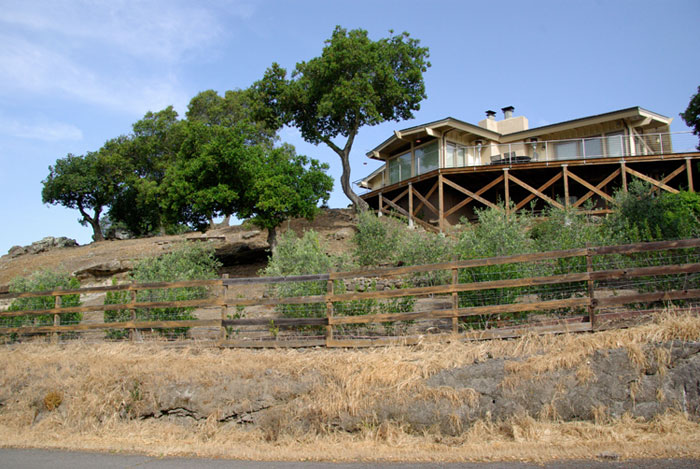Defensible Space: What It Is and Why it Matters to You

No matter where you choose to call home, understanding the potential natural hazards your property could face is essential for planning your future living arrangements. This is especially true if your NHD report indicates that your property lies in a very high fire hazard severity zone or wildfire hazard zone.
Wildfires are a very real threat to your home in California. The Verisk 2017 Wildfire Risk Analysis report found that over 2 million homes in California were at a “high” or “extreme” risk of wildfire. In 2018 alone, it is estimated that over 22,000 buildings were destroyed in the fires that raged across the state.
While you cannot control all factors related to fires, California homeowners can mitigate their risk by creating what is known as “defensible space” around their property. Understanding this key fire control principle could make all the difference in saving your home from a catastrophic event.
What Is Defensible Space?
The term “defensible space” is used in fire control terminology to describe an area that has been designed in a way that helps minimize fire danger. This can be accomplished through a combination of natural features and man-made landscaping.
Defensible space is typically comprised of two zones which extend a total of 100 feet away from the structure. The inner zone is known as the “Defensible Space Zone.” It extends 30 feet from the structure, though San Diego County requires that this area extends for 50 feet away from the structure. In this first zone, vegetation should be kept to a minimum, and efforts should be made to eliminate any combustible materials.
The next zone is known as the “Reduced Fuel Zone.” While more vegetation can be present here, both vertical and horizontal separation should be created through selective pruning and plant removal to reduce fire risk.
FEMA recommends the implementation of a third zone, covering the area that is more than 100 feet from the structure. Thinning and pruning should be performed here as well, whenever possible.
The Importance of Creating Defensible Space
Creating defensible space is vital in areas with large quantities of wild vegetation — though landscaping vegetation can also be quite combustible. As the previously cited FEMA document notes, “Vegetation can burn with great intensity and produce firebrands and burning embers that can become wind-driven hazards […] A wildfire can move horizontally from shrub to shrub and tree to tree. A wildfire can also travel vertically from the ground up into the treetops, resulting in a catastrophic crown fire (a fire that can travel at an incredible pace through the top of a forest).”
While wind can carry burning embers to nearby plants and structures, the risk for building ignition dramatically increases when combustible materials are kept close to a building. When a defensible space is created and the home uses fire-resistant roofing, the structure becomes much more likely to survive a fire.
Another important consideration in creating defensible space is ensuring that firefighters will have safe access to defend the area. Defensible space increases firefighters’ ability to defend your home from a fire. Without defensible space, your property could be too dangerous to protect especially when a large wildfire is threatening many homes in your area.
How to Create a Fire-Resistant Space
Needless to say, if you live in an area with significant wildfire risk, creating defensible space around your property should be a top priority. For all zones around your home, you should start by removing dead vegetation such as fallen leaves, dry branches and grass, and other materials that pose a fire risk.
Mature trees should have branches lower than six to eight feet above ground level removed. Trees should also be trimmed regularly so that branches are kept at least ten feet away from neighboring trees. Smaller trees or shrubs that have taken root underneath a mature tree should be removed entirely to minimize the risk of vertical fire spread.
Within Zone 1, homeowners should be especially mindful of tree branches that hang over the roof. These branches should be trimmed back, particularly from the chimney area, as overhanging branches could increase the risk of starting a fire.
Dry pine needles and leaves should be removed from the roof and rain gutters. All fire-prone vegetation should be removed and replaced with safer options such as a rock garden or irrigated grass.
“Manmade” fire hazards in Zone 1 should also be eliminated. Wood piles should be kept out of this area entirely. Decking or patios should be constructed from stone or other noncombustible materials. Similarly, you should replace all wood patio furniture with metal alternatives. Detached structures such as a utility shed should be located in Zone 2.
Creating horizontal and vertical spacing between plants is essential in Zone 2. Shrubs and trees should be spaced apart from each other and surrounded by noncombustible areas. Gravel walkways or a paved driveway are easy ways to create firebreaks in this zone. Wood piles and fuel tanks that are kept in this zone should be placed away from vegetation, such as on a concrete pad or patch of gravel.
Proper plant selection and care can further reduce fire risk. Shorter trees are less likely to pose a vertical fire threat. Low-volume vegetation that retains moisture will be less flammable and less prone to die-off, making it less combustible during dry conditions.
Slow-growing plants, as well as wind and drought-resistant plants, will be easier to care for as they will be less likely to leave dry plant waste in your yard. Ongoing monitoring and maintenance of your defensible space (including weekly lawn mowing) will ensure its continued effectiveness throughout the year.
A Fire-Safe Future
The threat posed by wildfires isn’t going to disappear anytime soon.
While 2019’s wildfire season hasn’t proved to be as devastating as the historic conditions of 2018, California’s climate situation ensures that homeowners in many parts of the state will continue to be at high fire risk in the years ahead. By creating defensible space around your property, you will give your home a fighting chance of being saved if fires come your way.

